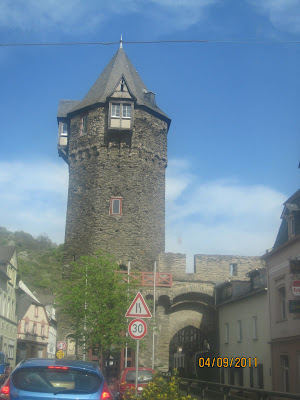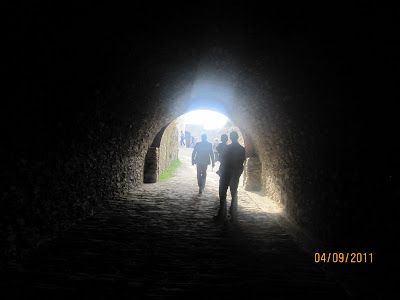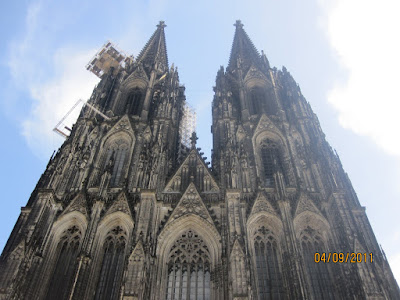Our first view.

Driving past the old town gate.

We had to hike a little ways from the parking lot to get to the castle.

Go over a drawbridge.

And through a tunnel with very uneven cobblestone streets.


Maddox, with his $5 bottle of castle Powerade that we had to get for him before the tour started.

View from the ticket office.

Our friend's son and Maddox playing while we wait.

At 4:57, right before the tour started Carson started getting fussy. I had forgotten a bottle in the car and Ben ran all the way down to get it. I was worried he would get left behind since our guide showed up early and started ushering people inside. Thankfully, she was nice and waited for Ben to make his way back up.
Marksburg Castle is the only hill castle on the Rhine that has never been destroyed. It has been lived in for 700 years. Unlike other Rhine castles that were rebuilt from ruin, Marksburg is quite genuine.
A wall showing the succession of ownership of the castle since 1283 and their coats of arms.

Castle tower with the guard's quarter.

The oldest cannon, from 1450.

The more efficient cannons from 1640.

The view out the opening.

Medieval Garden along the outer wall with 160 plants from the middle ages used for cooking, medicine, and witchcraft. The Schierling (hemlock) is the poisonous one that killed Socrates. We made sure Maddox didn't touch any plants.

After the garden we walked along the outer wall and the tour guide pointed out a brown overhang high up the wall. I heard her say toiletten and later figured out that was an outhouse and they would just let the waste drop to the ground as they went. yuck. Unfotunately we didn't get a picture of the outside of this.
Next we went to the the wine cellar.

Wine has been the traditional Rhineland drink since Roman times. Castle water was unpure, so wine was the way knights got their fluids. The large pitures above the barrels were each knights daily allotment. Quite a bit of wine!

Up the stairs we go to the kitchen with a wine press from 1767.

It has an oven designed to cook an ox whole. The windows were made of thin alabaster or animal hide and the walls are 4.5 meters thick.
Me, Carson, our friend Jade, and Brandon infront of the oven.


On to the bedroom, the only heated room in the castle. Note the tiny bed and bassinet.

The doorways were tiny. Here is Jade's husband, Dale, squeezing through.

This shows some of the materials that the wall was made out of.

Medieval instruments.

Next we went to the Great Banqueting Hall, The Hall of Knights, which had a huge fireplace, and the outhouse!! Personally, the outhouse door was way to close to the dinning table for comfort. This was the portion that was hanging over the outer wall in thin air. When not in use they locked it from the inside to prevent invaders from getting in.


The table top was an unattached plank of wood. After each course the servants would replace it with another premade plank. Even now, when germans are done with a course they have been known to say "Let's lift up the table."

Gothic chess set.

The chapel had painted walls and ceilings and is dedicated to St. Marks (hence: Marksburg).


Even the chapel was designed with defense in mind. There is a short and narrow doorway, which kept out heavily armed attackers (even I had to turn sideways to fit through.)

The staircase spirals clockwise, to favor the defender (assuming he was right handed.) Attackers swords would catch against the wall.

Two thousand years worth of armor are kept in the armory. Because helmets covered the face, soldiers identified themselves by tipping their visors up. This evolved into the military salute.

Our guide let Maddox try on a real helmet that was in the display.

And hold one of the swords.

This is the horse stable, but it shows off crime and punishment things (I didn't really like that part.)

This was the last stop. We headed back out the same gate we came in, and our tour guide let Maddox lock the castle up. I tried to get a picture of this with Ben's phone because our camera battery ran out, but I missed it.
Here are a few more photos from the Marksburg Castle.







I hope you enjoyed your tour. Auf wiedersehen!!


































